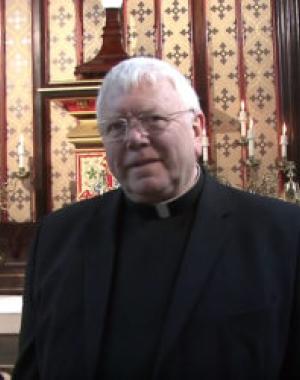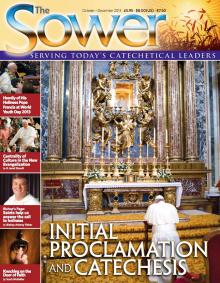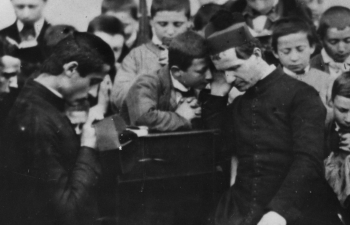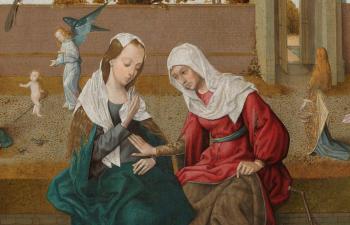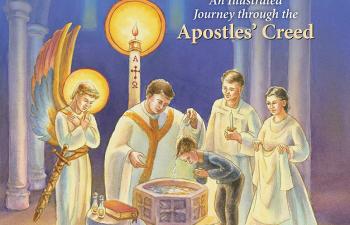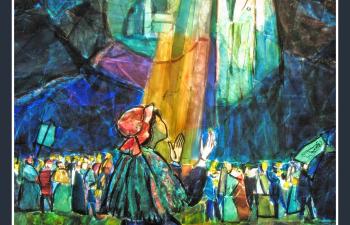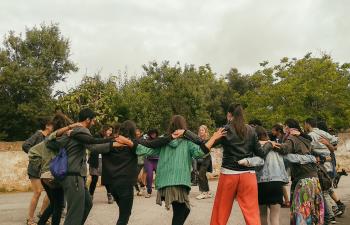In this article, Mgr Paul Watson looks at the Eucharist as the source and summit of initial proclamation.
I recently heard the witness of a young man, an artist, struggling to make sense of his life and the state of society today. He had received no Christian upbringing, but had a sense of goodness and beauty in the world. Nevertheless, he was deeply troubled by the inconsistencies he found within himself and in the world around him. How easy it was to make choices that led to greater confusion and misery. Where in society can one find a deep sense of purpose and hope?
It was in this state of bewilderment that this young man wandered into a Catholic Church – perhaps to find a bit of peace and quiet to think! In fact, he had stumbled into the celebration of a sung Mass. As the Mass proceeded, the young man became more and more aware of an event that was both beautiful and uplifting. He tried to pay more attention and realised that this rich event seemed to revolve around the proclamation of the death and resurrection of Jesus Christ. The words, the music and the actions all seemed to be centred on the person of Jesus and on the fact of his sacrificial death and resurrection and yet, at the same time, coalesced into a great act of worship and praise of God.
The experience had a profound effect on him. There and then his faith in the living Jesus was born, as well as a dim awareness, at first, that the answers to the things that were troubling him could be found in this person, and strangely, in the mystery of his death and resurrection. Following this experience, his enquiries led him to be received into the Catholic Church and to full participation in the sacrament of the Eucharist, which had so deeply affected him.
Those of us who are accustomed to regular Sunday Mass might be a little surprised by this story. We might be surprised to learn too that it is far from being unique. Perhaps the young man was fortunate in entering a Church in which the liturgy was carefully and beautifully carried out. However, there are many who have been moved to faith by their first contact with the celebration of the Eucharist. Perhaps they see something that has become so familiar to us that we no longer notice it.
Remain with us, Lord
In October 2004, Blessed John Paul II wrote a letter to the Church called “Remain with us, Lord” in which he reflects on the meeting on the road to Emmaus between Jesus and the two disciples. He says that this gospel incident can help us engage more deeply with the mystery of the Eucharist during this year. For Jesus walks by our side in the midst of our joys and sorrows, even as he walked with the two disciples. As Jesus opened their minds to see how all of the Scriptures point to him and to his work of redemption, so he does the same today. With their minds thus enlightened, they were able to glimpse his hidden presence in the “breaking of bread” and became witnesses to others.
The event of the disciples’ meeting with Jesus, according to the Holy Father, highlights two important aspects or features of the Mass, our celebration of the Eucharist. First of all, Jesus explained the Scriptures to them, showing how they pointed to the Messiah who was to come to redeem the world through his suffering and death. He was to bear the sins of the whole of mankind in order to reconcile humanity to God. Rising from the dead he would become the source of the new life of the Holy Spirit, transforming human beings and indeed all of creation until his final coming and the full establishment of the Kingdom of God. The disciples remembered that their “hearts burned within them as he explained the Scriptures” to them.
The celebration of the Eucharist is first of all “the table of the Word”. Through the prayers, the Scripture readings, the responses and the homily, Jesus is present among us opening our hearts to the message of the Gospel. In the Mass, it is the work of the Holy Spirit to touch our hearts and to move us to deepen our faith in Jesus.
The second feature of the Mass is the “table of the Eucharist”. What is proclaimed in the Word is enacted in the sacramental action of the Mass. The gospel message is not only proclaimed and explained, it is also made present. This is what is meant by calling the Mass a “memorial”. But it is important that we understand the significance of the word “memorial”. Jesus told his apostles, at the last supper, to do this in memory of me. He took bread and wine and said: “This is my Body, which will be broken for you. This is my Blood, which will be poured out for you.” He made the bread and wine become the sacramental presence of the very sacrifice of himself by which humanity is reconciled to God. By eating and drinking with Jesus at the last supper, the apostles were actually sharing in Jesus’ sacrifice – its power to liberate us from sin and to unite us intimately to the Father. The apostles failed to understand this at the time, but as they began to be obedient to Jesus’ command to them, the Holy Spirit showed them the amazing truth that their action really made present the sacrifice of Jesus.
Goal of Initial Proclamation
The message of the Gospel, God’s plan of redemption in Christ, is proclaimed in the liturgy of the Word and enacted in the Liturgy of the Eucharist. There is a real sense in which every celebration of Mass is an occasion of initial proclamation of the Gospel. As I mentioned at the beginning of this article, it is possible that the very thing that is most familiar to us tends after a while to become invisible. In one way or another the scripture readings, the Liturgy of the Word as it is called, and the prayers and responses that surround it, witness to the person of Jesus Christ and the gospel message he proclaimed and brought to fruition by his death and resurrection.
Nowhere is this more true than in the various liturgies of the Lent and Holy Week season. In particular, the Gospels of Lent reveal the mission of Jesus: as the Suffering Servant revealed at his Baptism; as the One who overthrows the tyranny of Satan revealed in the temptations in the wilderness; as the One who brings forgiveness and life to the woman at the well of Samaria; as the Suffering Servant who becomes the head of a new humanity at his Transfiguration; as the One who opens the eyes of the blind, raises the dead to life. The liturgies of Holy Week are both a proclamation and enactment of the days of Jesus’ passion, his sacrificial death and glorious resurrection.
The enactment of the Gospel
What sort of action is the action of a sacrament? Sacraments are the life-giving and transforming actions of the Risen Christ himself. Although the sacraments are carried out by the Church, often indeed, by a single minister of the Church, nevertheless, the Church or the Church’s minister only ever act in the name of Christ. Without the living presence of Jesus and the action of his Holy Spirit, the sacraments would be mere rituals, simply human acts with no power to transform those who participate in them.
What, then, is the action of the Eucharist? We are familiar with what takes place. We can observe plainly the liturgy of the Eucharist and see that a priest is standing at an altar on which he has placed a dish of bread and a cup of wine. During the prayers that follow the priest several times lifts the bread and the wine – at first separately, then both together, and finally, the bread is lifted up again as an invitation to come and eat. These simple actions, along with the words that accompany them, re-present the enactment of the gospel message.
It is worth pausing at this point to ask yourself to what extent you see and realise that the Gospel is being acted out in the words and actions of the priest. Have you ever thought about the actions of the Mass in this way? You may be puzzled by the question. It is surely easier to see the Gospel acted out in a dramatic recreation of the events of the Passion, for example in a film or in a dramatised play or musical. In such dramas it is clear that Christ endured fearful suffering and torment culminating in a heart-wrenching cry as he expires pinned to the wood of the Cross. The last words of Christ link his suffering and death with a plea for the forgiveness of God for the human race and a complete surrender of his life into his Father’s hands. The Father’s response was to raise his Son to life and glory.
It is interesting and significant that in our regular celebrations of the Eucharist none of the drama just described is being acted out as if in a play. The nearest we come to acting this drama is on Good Friday – reading the Passion; carrying a veiled Cross; unveiling the Cross and offering prayers for the whole of mankind. Yet paradoxically, Good Friday is the one day that we do not actually celebrate the sacrament of the Eucharist!
The mysterious truth is that in the celebration of the Eucharist the whole drama of the Passion, Death and indeed the Resurrection of Christ is stripped down to its very simplest form in order that we might both understand the depth of the mystery and also share or participate in it in the most profound way. It was Jesus himself who gave us this way of celebrating the paschal mystery by his words and actions at the Last Supper.
The Bread of Life and the Cup of Salvation
The key to understanding all of this is to be found in the bread and wine placed by the priest on the altar. From the first moment of the liturgy of the Eucharist – the procession of the gifts and Offertory – the bread and wine begin a process of transformation. In the first place, they become our personal offering to God, representing our gratitude to God for his creation, for his blessing on our labours, indeed they represent our very lives, albeit our fallen sinful lives (which is why the priest washes his hands in repentance). When the priest lifts first the bread and then the wine, they are being offered to God on our behalf as an act of praise and thanksgiving to our Creator. But from this point on the action takes on a profoundly new dimension. The bread and wine are changed by the Risen Christ himself.
In the most simple way, by repeating the words of Jesus at the Last Supper and by raising first the Host and then the Cup two profound changes are indicated. In the first place, Jesus - God made man - has taken our sinful humanity represented by the gifts, and made it his own. He has taken our sin in order to suffer for it on our behalf. “On the day before he suffered, he took bread … and said: this is my body”. The bread which, in the words of Cardinal Ratzinger, represented the dirt of our humanity, now becomes the sacramental body of humanity’s redeemer, who redeems humanity through suffering and death.
The words of Jesus provide us with the second profound change” This is my body which will be given up for you”, “This is the chalice of my blood .., which will be poured out for you and for many for the forgiveness of sins”. The words in italics indicate Jesus’ death; indeed, a sacrificial death. Jesus not only took on the suffering of sinful humanity, he made his own death a sacrifice to atone for our sins. It is this deep truth, the very heart of our faith, which is made present through the very simple act of separately consecrating and elevating first the Body of Christ and then the cup of his Blood. The separation of his Body and Blood is the sacramental sign of his death! As I have said, it is the very drama of the paschal mystery stripped to its simplest form. It is so simple that it is possible to miss it. We must not only see with our eyes, but also listen with hearts of faith to the words of Jesus, if our hearts are to burn within us!
Communion with Christ and the Father
At the end of the Eucharistic prayer, the priest once again lifts the host and the cup and offers this prayer to the Father. “Through him, and with him, and in him, O God, almighty Father, in the unity of the Holy Spirit, all glory and honours is yours, for ever and ever”. This is the climax of the action. Christ sacrificial death on behalf of sinful humanity is offered in worship of the Father. In accepting the sacrifice of his Son, the Father also accepts us all because of the deep bond that Jesus has established between himself and humanity. We are reconciled to the Father as his beloved sons and daughters. This most intimate union with the Father is fulfilled and expressed in the prayer that follows: “Our Father …”
The climax of the liturgical drama and enactment of the gospel message of salvation is inaugurated by the final elevation of the Host. With this action and the accompanying words “Behold the Lamb of God …”, the priest invites us to participate even more deeply in the mystery of our salvation. “Blessed are those called to the supper of the Lamb”. Since the enactment of the gospel message of salvation through Jesus’ death and resurrection has taken place through liturgical rites centring on the changed bread and wine, our fullest response is to eat and drink. We not only receive the Body and Blood, soul and divinity of Christ, we also appropriate the salvation He has achieved for us.
Let us ask the Holy Spirit to open our eyes and hearts to see in our celebration of the Mass both the proclamation and enactment of the gospel message. Our participation in the whole liturgy and our receiving of Communion is our way of personally responding to and embracing the Gospel. Thus fortified, we “Go in peace”.
This article is originally found on pages 14-17 of the printed edition.
This article is from The Sower and may be copied for catechetical purposes only. It may not be reprinted in another published work without the permission of Maryvale Institute. Contact [email protected]


